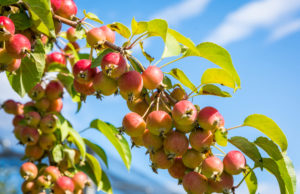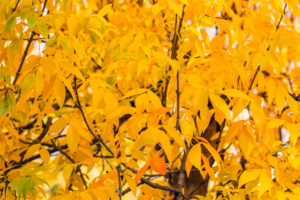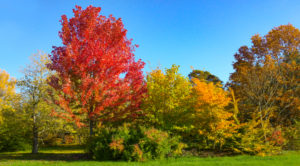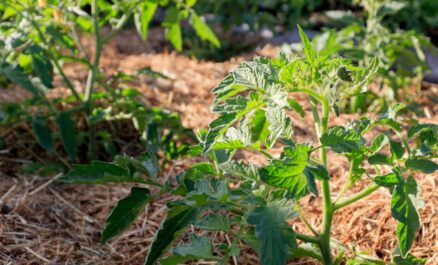The Best Deciduous Trees For Australian Gardens
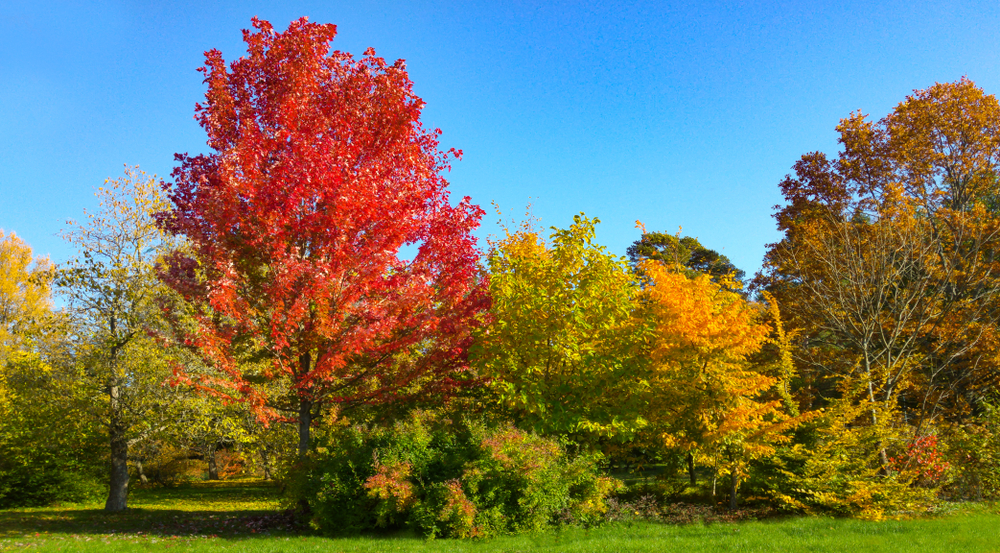
Many Australian gardens and landscapes are filled with a variety of trees. Trees offer a range of benefits from providing shade to filtering the air we breathe and providing habitats for wildlife. And, of course, trees have a range of aesthetic qualities that enhance outdoor spaces due to their shape, size, height and ability to bear flowers or fruit. One of the more popular types of trees are those that provide a burst of colour during the autumn months and these are known as deciduous trees. But what are they, and what are some of the most common varieties available?
What are deciduous trees?
In the fields of botany and horticulture, deciduous trees are those that are seasonally adaptive, which results in a glorious rainbow of colour in autumn, typically from early March to the end of May. They then shed their leaves in preparation for winter, and leaves flourish again in late spring, changing from green to warmer shades again. There are few of these types of native Australian trees, but you can still grow plenty of species imported from other countries.
What are the most popular deciduous trees in Australia?
In terms of deciduous trees in Australia, here are some of the most popular to grow.
Chinese Pistachio (Pistacia chinensis)
 This tree has a moderate growth rate and can reach a height of around eight metres. It has dense foliage and can provide shade for plants to grow in its undergrowth. Its bark is dark grey, and in autumn, it offers colourful leaf shades of yellow, red and orange. Green leaves emerge in spring, followed by clusters of small white flowers in summer, followed by red fruit, which matures to blue. This tree can withstand relatively harsh conditions and is great for gardens of all sizes. Pruning it will keep its shape and maintain a good overall structure.
This tree has a moderate growth rate and can reach a height of around eight metres. It has dense foliage and can provide shade for plants to grow in its undergrowth. Its bark is dark grey, and in autumn, it offers colourful leaf shades of yellow, red and orange. Green leaves emerge in spring, followed by clusters of small white flowers in summer, followed by red fruit, which matures to blue. This tree can withstand relatively harsh conditions and is great for gardens of all sizes. Pruning it will keep its shape and maintain a good overall structure.
Chinese Tallow Tree (Triadica sebifera)
The Chinese Tallow is a medium-sized tree with green, heart-shaped leaves that turn orange, yellow and crimson in autumn. These trees have a spreading canopy and can reach a height of up to 18 metres. It is a fast-growing tree with a distinct main trunk and grey bark with furrows that run from top to bottom. This variety starts off as a pyramid shape when young and develops a medium domed crown as it matures. In spring, yellow-green flower clusters are produced, followed by small capsules that open to reveal white, waxy seeds. They are drought-tolerant, but need deep watering during long, dry months to prevent pale-coloured leaves and early leaf drop.
Claret Ash (Fraxinus angustifolia)
Claret Ash trees are well-loved among garden owners with foliage that changes to a purplish deep red during autumn. They have a moderate growth rate and can reach a height of 16 metres at maturity, and their growth habit is oval in shape as a mature tree. This tree is drought and frost-tolerant and not particular about soil type, although they thrive in moist, well-drained soils and in full sun. They are suitable for medium-sized gardens, are ideal as a shade or specimen tree, and look wonderful lining a driveway.
Crab Apple (Malus sylvestris)
One of the very best Australian fruit trees, the Crab Apple tree is valued as a spring-flowering ornamental tree, and with some varieties, for the fruit that is used widely in jellies, jams and for apple cider. They are grown for their ornamental appearance, with leaves turning a warm orange/red colour in autumn, but also to aid in cross-pollination with other apple trees. Pink and white flowering varieties are available, and they are a lovely spreading shade tree, although dwarf varieties reaching a maximum of around three metres are also available. This is a hardy tree that copes well with a range of conditions and requires little care or pruning once established.
Flowering Cherry (Prunus serrulata)
This small deciduous tree is considered one of the showiest flowering cherry trees as its flowers are large and vibrant pink. Foliage is deep bronze-coloured initially before becoming dark green above and paler underneath. In autumn, the Flowering Cherry leaves transform into deep shades of red, yellow and orange. The tree begins with a narrow form but spreads out upon maturity. It can tolerate part-shade or full sun, and likes most soil types but thrives in a humus-rich one.
Golden Ash (Fraxinus excelsior “aurea”)
The name of this stunning tree says it all. The leaves of Golden Ash trees turn from yellow in spring to pale green in summer to a dazzling golden colour in autumn. However, aesthetically, they are a “tree for all seasons” as the young branches are yellow with distinctive black buds during winter. They have a rounded crown and can be used in any sized garden, and offer great shade. Golden Ash will tolerate wet conditions and moderate, dry conditions, however, prefer cooler areas and moist soil for best results.
Indian Bean Tree (Catalpa bignonioides)
This tree grows to a height of fifteen metres and exhibits showy floral displays and a luxurious shady canopy. The creamy “foxglove-like” flowers with purple spotting appear in summer, leaving clusters of long slender beans. Its large velvety heart-shaped leaves turn yellow in autumn. Mature trees are often wider than they are high with large spreading branches and are a useful shade tree for large gardens. This sun and moisture-loving tree is tolerant of any well-drained soil.
Japanese Maple (Acer palmatum)
In terms of the best low maintenance trees for your garden, you can’t go past the Japanese Maple. This tree is impressive to see from afar but just as breathtaking up close. Its star-shaped leaves make this tree a standout in any garden and hard to miss during autumn, with leaves that turn a glorious shade of yellow, red, purple or orange. Foliage in spring is light green and they are ideal for not-so-big gardens as they thrive in small spaces, including in large pots. They prefer organic-rich, well-drained soil, part shade and a sheltered spot as their leaves can be easily spoilt by wind and sun.
Lipstick Maple (Acer rubrum)
These deciduous trees have an elegant upright form and star-shaped leaves that become the deepest, richest hues of crimson in the autumn. They are well-suited for use as a feature tree and can also be used to line driveways. Because of their large crowns, they are also ideal in larger gardens. Varieties include “October Glory” which has foliage that lasts into early winter, and “Autumn Blaze”, which has a dense growth habit. All varieties grow best in humus-rich soil in full sun or part shade.
Maidenhair Tree (Ginkgo biloba)
This deciduous tree turns a bright golden yellow colour during autumn. Their fan-shaped leaves may look dainty, but these trees can grow to a height of 30 metres over time. However, they are slow-growing, so suitable for most Australian gardens. Being a dioecious plant, a Ginkgo can be either male or female, and they thrive in areas with full sun and well-drained soil. Ginkgos are a popular choice among urban planners for lining parks and city streets because they are practically indestructible, which means the cost of maintaining them is low. They are almost impervious to pollution, disease and pest infestation.
Scarlet Oak (Quercus coccinea)
Scarlet Oak is a great feature tree that is a lovely autumn colouring tree for the cooler zones of Australia. It grows to around 24 metres tall and has bright green, bristle-tipped leaves that turn brilliant scarlet in autumn. Highly ornamental, it is fast-growing with an open, wide-spreading habit. Spring sees glossy green, new foliage and its young bark is relatively smooth and grey, darkening with maturity. With a tendency to flare out at the base, it makes for an excellent shade tree but needs a good amount of space to thrive. It is known to adapt to a variety of sites and tolerates most soils in a full sun position, however, it will perform particularly well in drier sites with sandy soils.
Silver Birch (Betula pendula)
This is a small to medium tree that can grow to a height of around nine metres. Silver Birch has a stunning white trunk with fine, weeping branches and an elegant, cascading crown. It has some of the purest gold autumn foliage and, when dormant, creates an interesting silhouette with its catkins and leafless crown taking on a purple tinge in the winter sun. Non-invasive roots mean they can be a great backyard garden tree that will grow well in a number of conditions as long as there is ample summer moisture.
Sweetgum (Liquidambar)
Sweetgum is a large hardwood tree with a conical structure and flame-coloured leaves, particularly when the weather is colder. Chilly autumn nights make this tree’s orange, yellow, purple and red leaves all the more vivid. As one of the last deciduous trees to shed their leaves in autumn, you’ll be treated to these magnificent colours until the end of the autumn season. Their name comes from their sweet-smelling resin, and these trees can grow to a height of 40 metres. If you’re after a smaller variety for your backyard, consider “Gumball” and “Parasol”. They are reasonably easy to grow, they aren’t fussy about soil type and will thrive in full sun.
Tupelo (Nyssa sylvatica)
This is a deciduous tree native to the north-eastern parts of the US. It has ornamental bark, dark branches, a beautiful pyramidal shape, and deep green foliage that turns yellow to scarlet in autumn when it produces clusters of smallish blue egg-shaped berries. These striking trees can reach a height of 30 metres, so they are ideal for larger gardens. They grow well in moist, well-drained soil and in full sun.
References
- Jamie Donovan, 2021, The best Autumn trees in Australia, Lawn.com.au
- 2021, What are deciduous trees? Tree Lopping Pros
- 2021, Pistacia chinensis, Specialty Trees
- 2021, Claret Ash, Advanced Trees Direct
- 2021, Crab Apple, Nurseries Online
- 2021, Prunus serrulata ‘Kanzan’, Specialty Trees
- 2021, Fraxinus excelsior ‘Aurea’, Specialty Trees
- 2021, Acer palmatum, Specialty Trees
- 2021, Acer rubrum, Nurseries Online
- 2021, Nyssa sylvatica, Specialty Trees
- 2020, Best autumn trees and plants, Burke’s Backyard
- 2021, Quercus coccinea, Specialty Trees
- 2021, Deciduous tree nursery, Small Tree Farm



